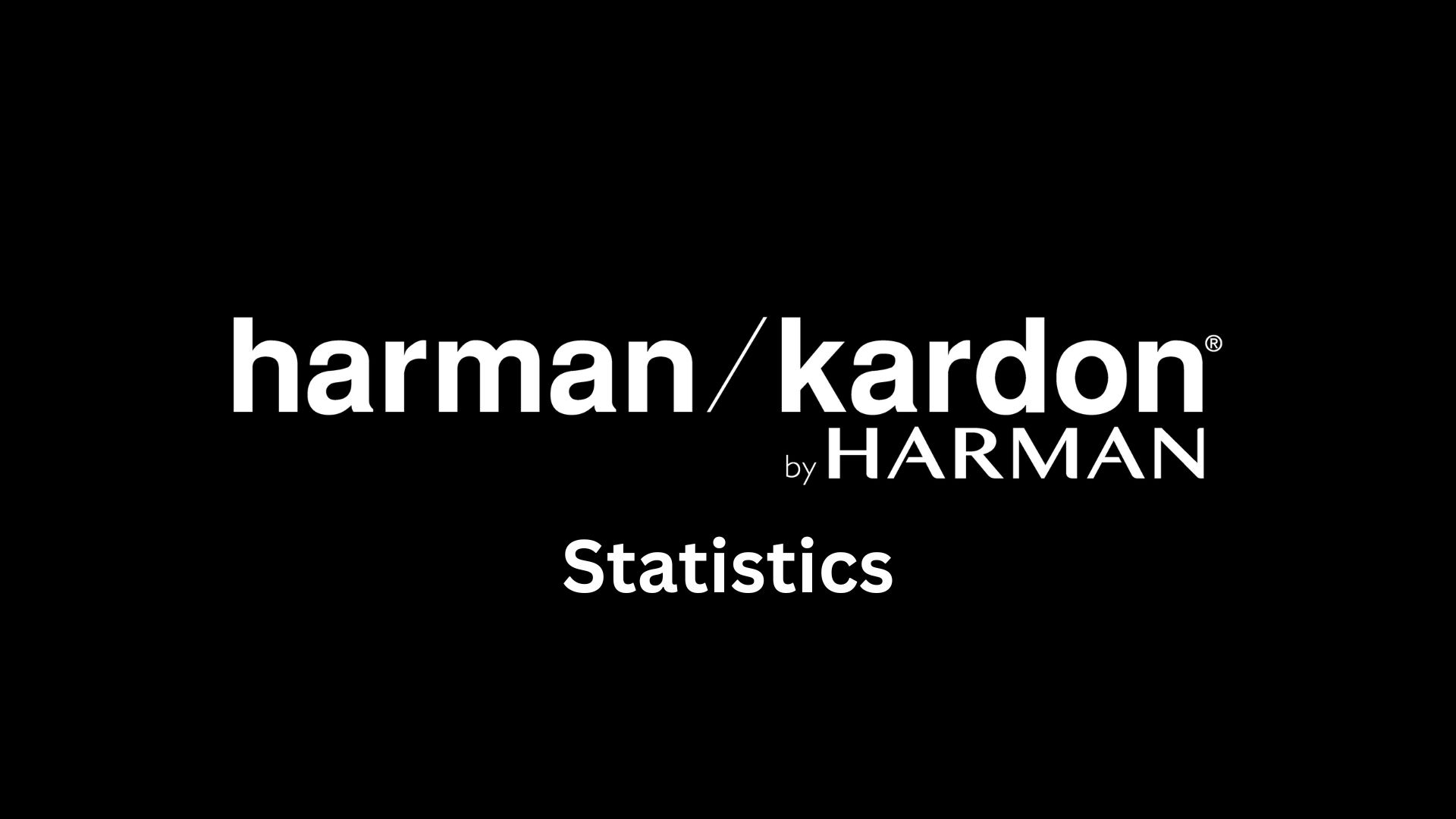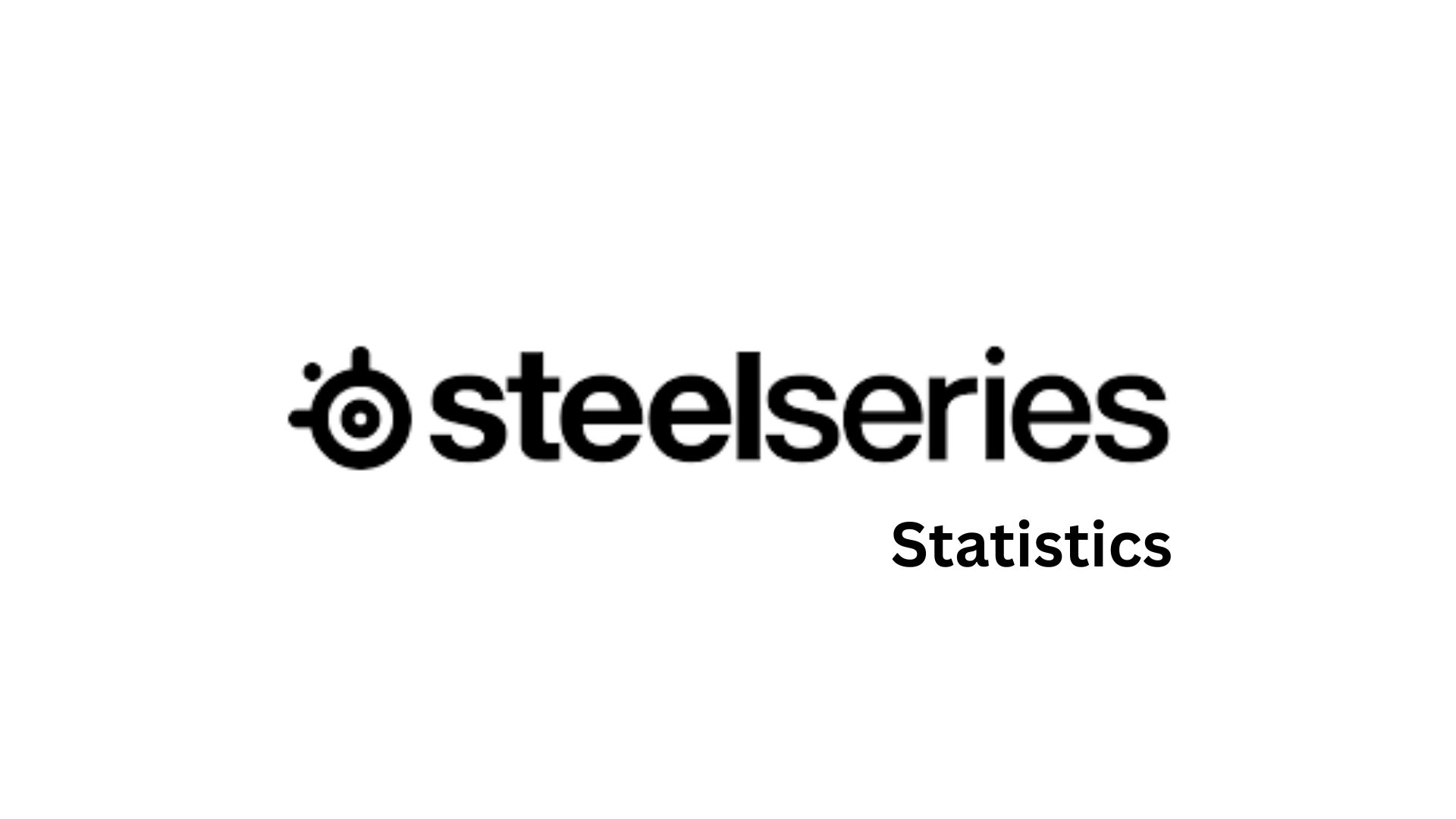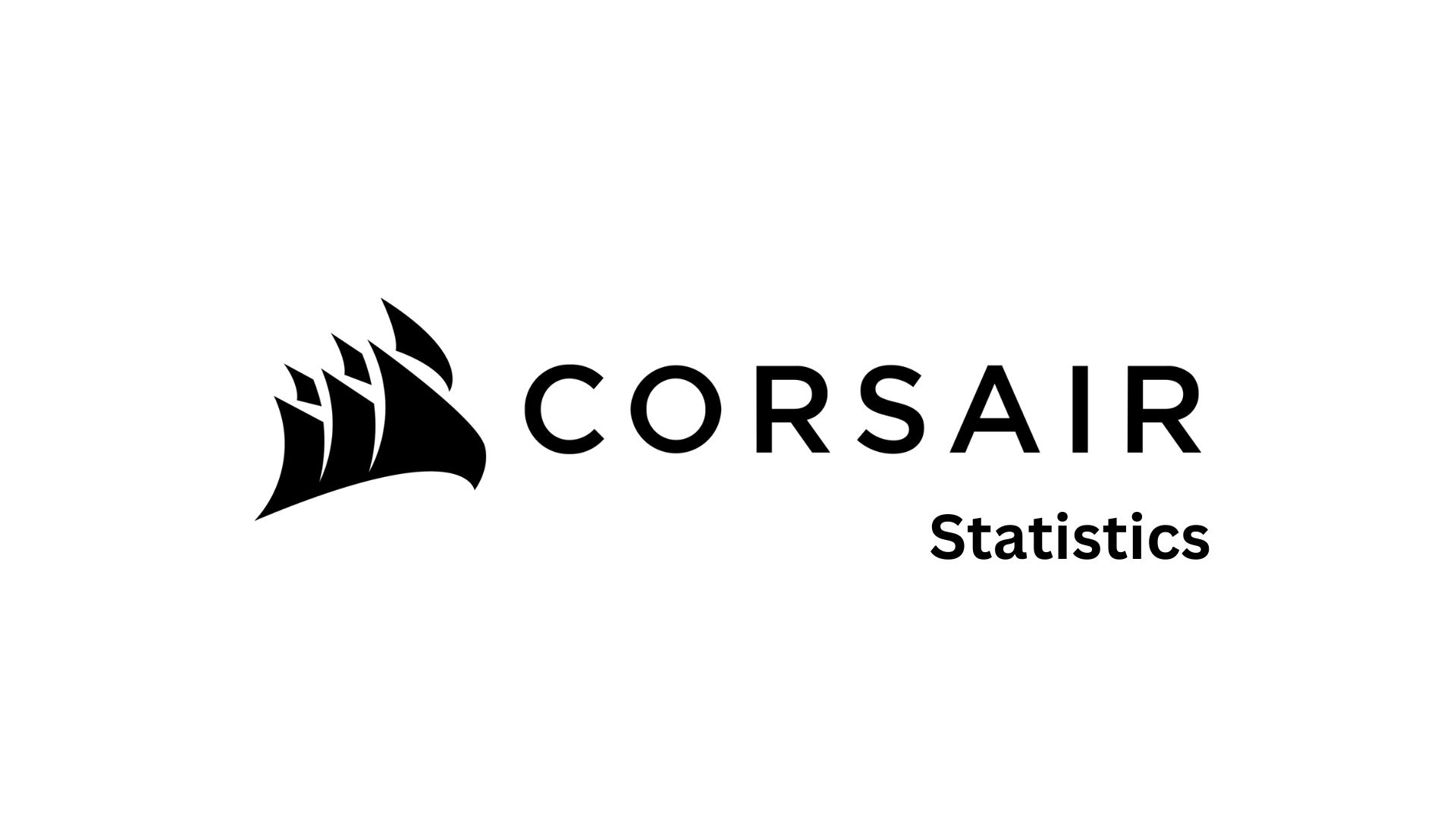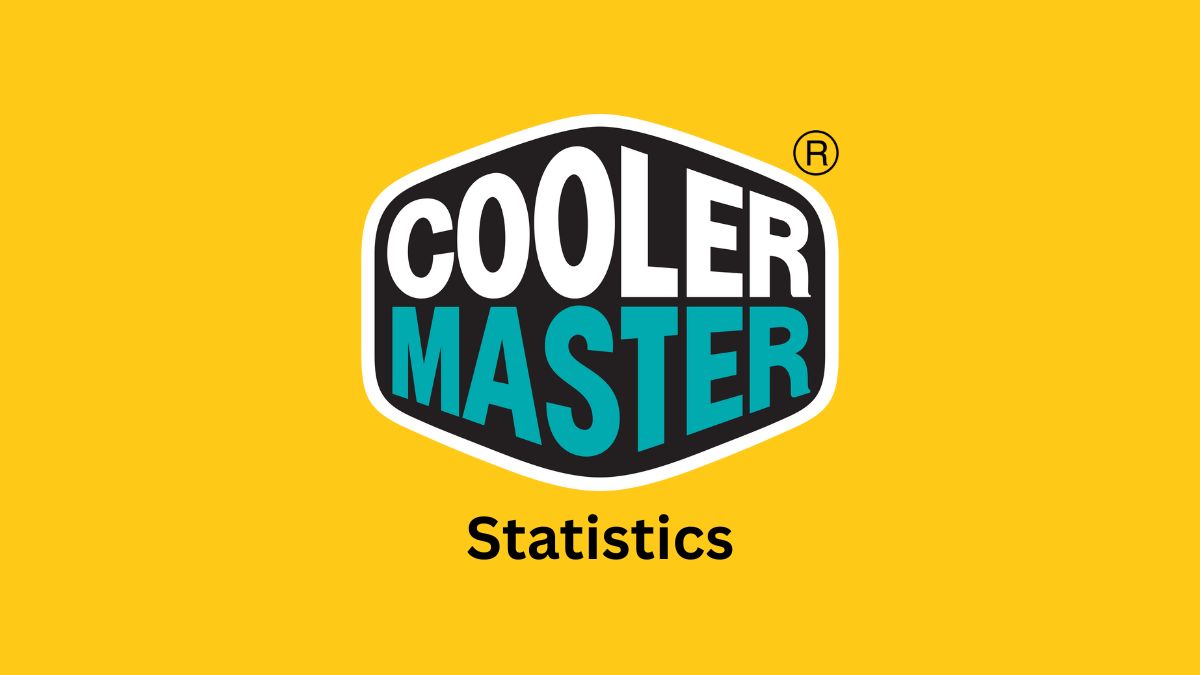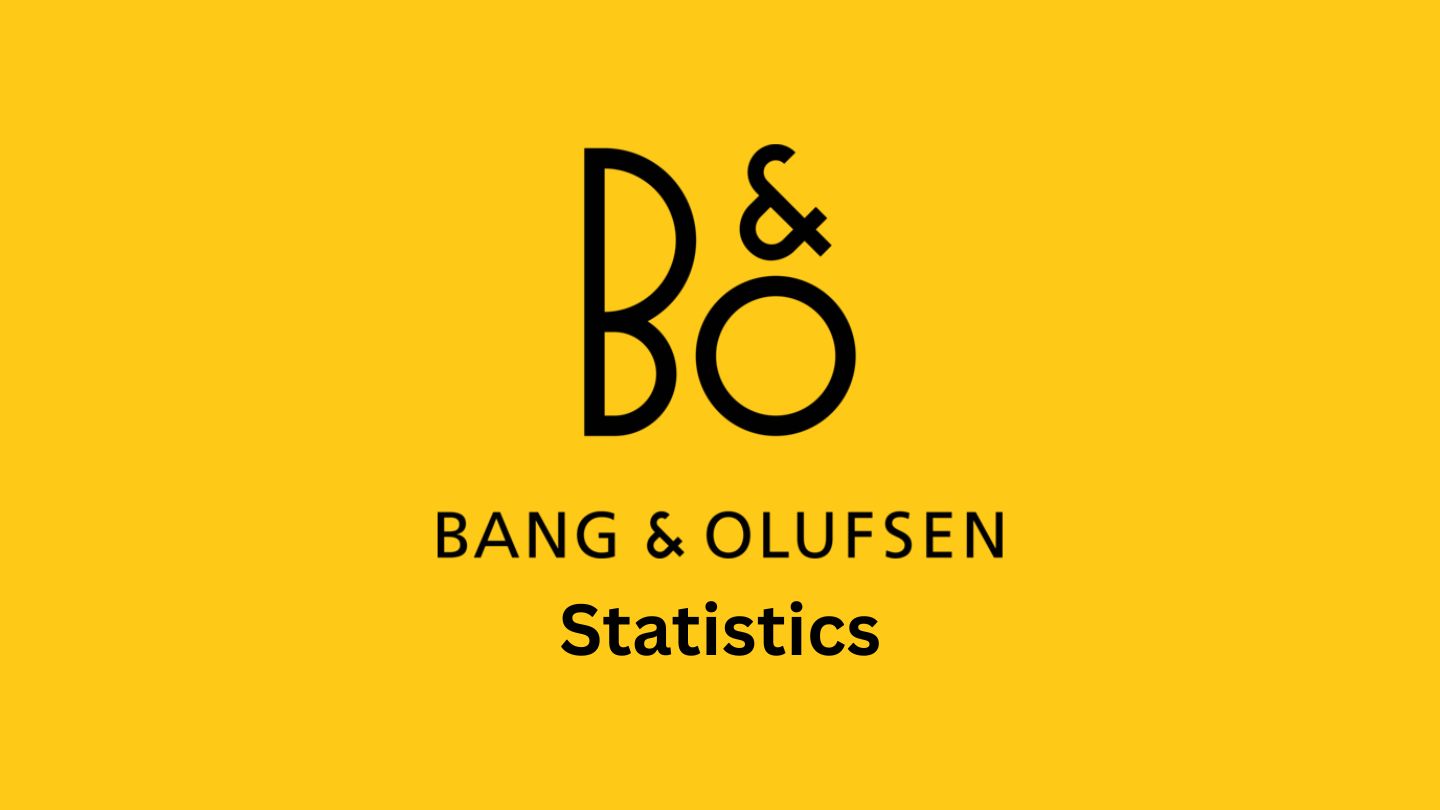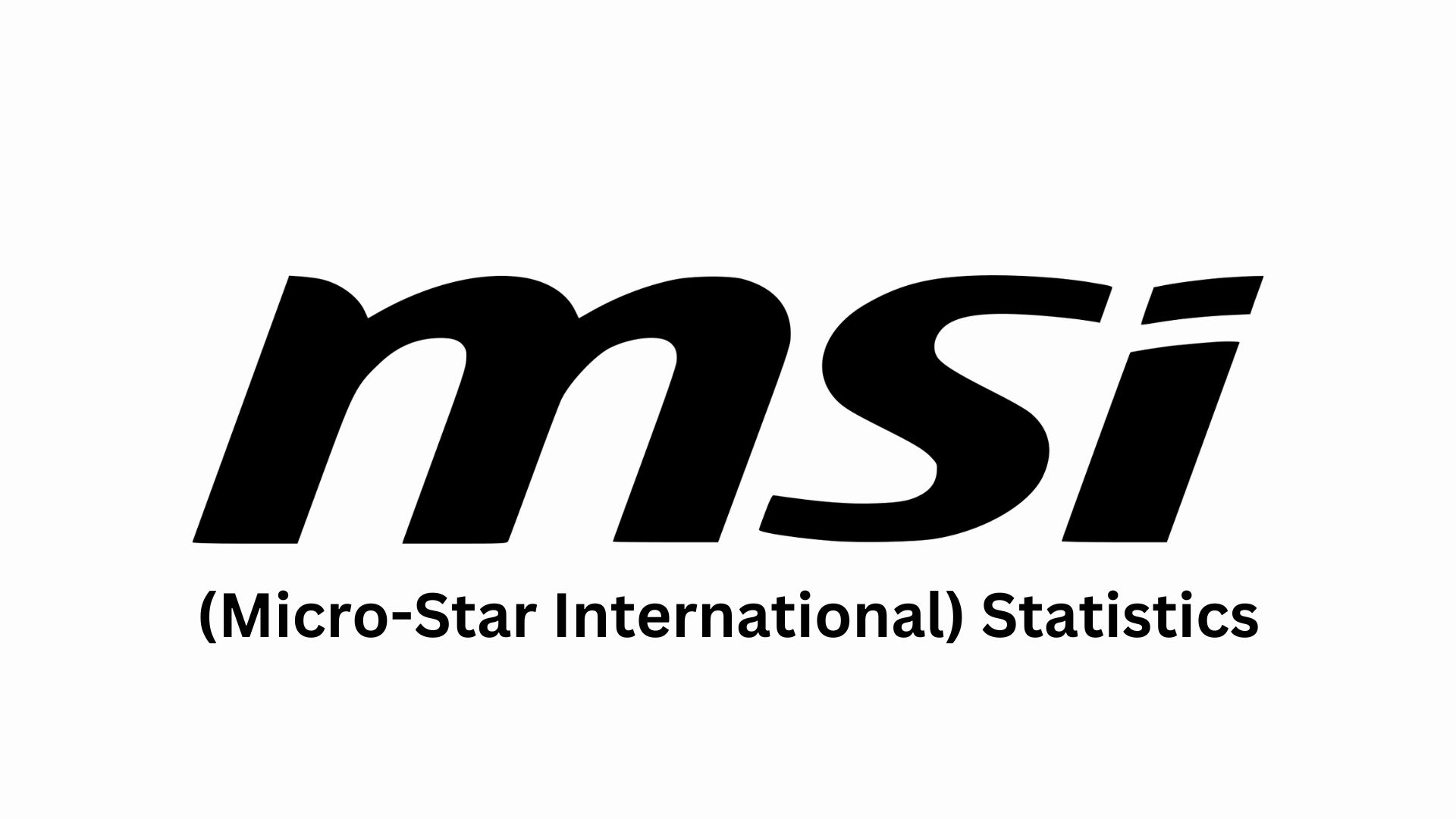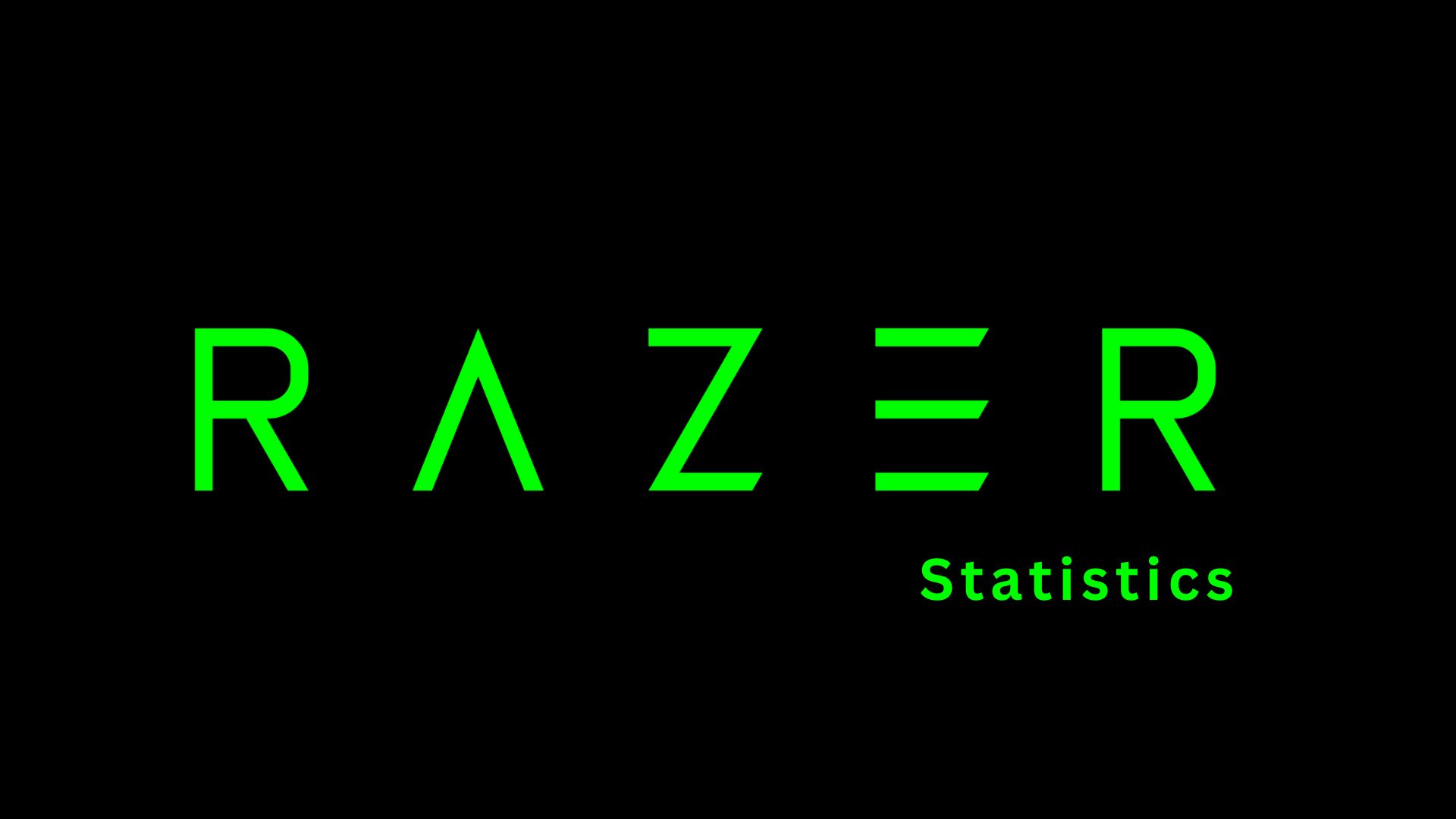Digital Pen Statistics and Facts By Market Size, Regional, Usage, Revenue, Key Players and Trends (2025)
Updated · Sep 14, 2025
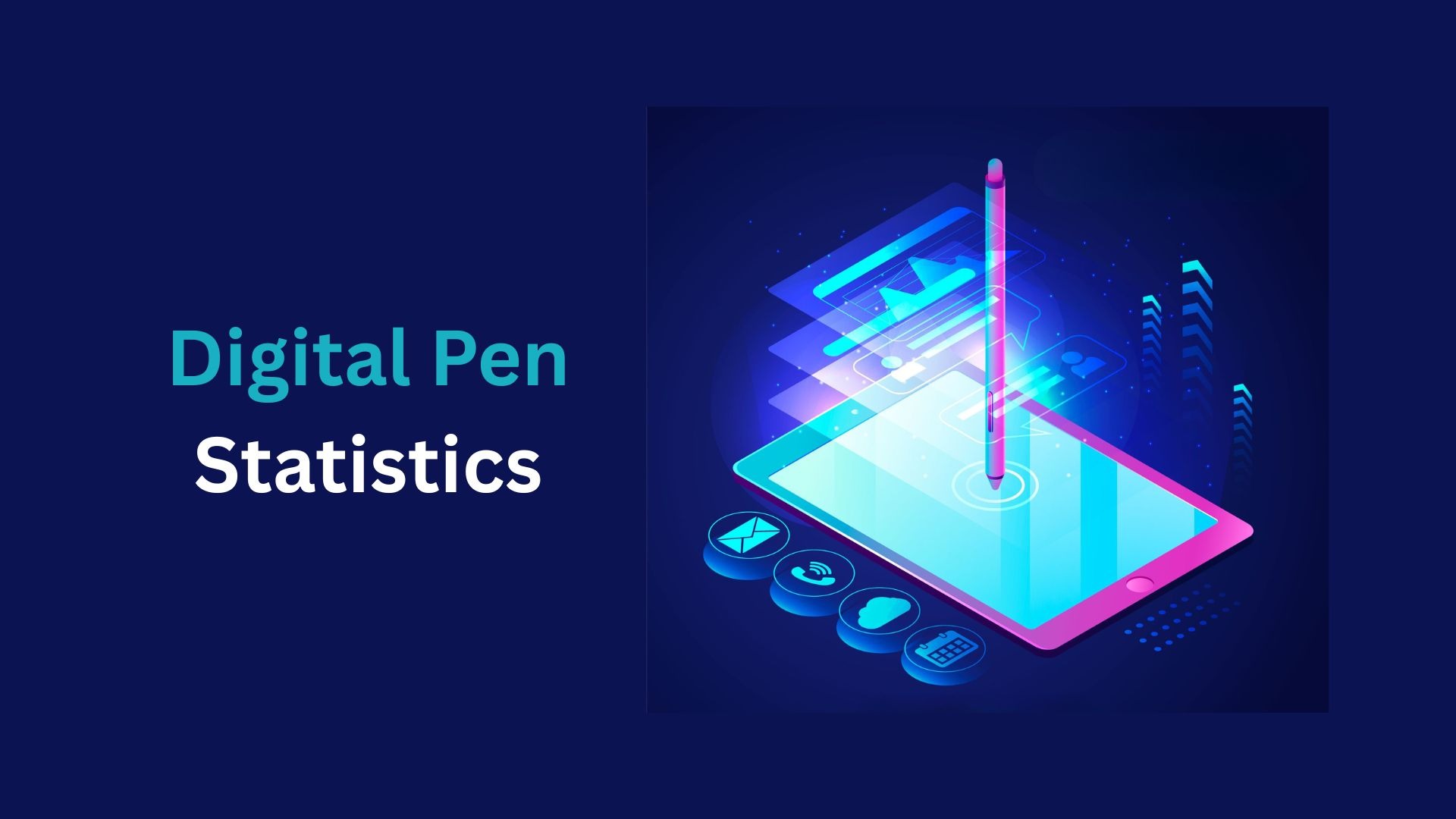
Table of Contents
Introduction
Digital Pen Statistics: Digital pens, also known as styluses, are compact tools that allow users to write, draw, and interact with devices such as tablets, 2-in-1 laptops, e-ink notebooks, interactive whiteboards, and smartphones. In 2024, the popularity of digital pens continued to rise, driven by their versatility and ease of use. These tools are increasingly adopted across various sectors, including education, art, healthcare, and business, enabling precise input and enhanced digital interaction.
Schools use digital pens to facilitate learning and interactive lessons, artists rely on them for detailed digital illustrations, and professionals integrate them into workflows for note-taking, design, and presentations. As technology advances and more devices become pen-enabled, digital pens are becoming essential accessories for both personal and professional use, supporting creativity, productivity, and efficiency across multiple applications.
This Article will discuss the recent Digital Pen statistics.
Editor’s Choice
- The global digital pen market was valued at US$701M in 2023 and is estimated to reach US$1.86B in 2032, growing at a CAGR of 11.8%.
- Handwriting pens held a market share of over 62% in 2022, demonstrating a strong preference toward note-taking and signatures.
- With a 47% share in 2022, tablets also led the market, registering global sales of 59.2% in 2023 and expected to grow at a rate of 14% CAGR from 2024 to 2030.
- The U.S. market was forecasted to grow by a CAGR of 13%, with the growth mainly driven by education adoption (e-exams, e-notes, digital textbooks).
- The Asia-Pacific market is expected to grow at a CAGR of 14.6% (2024–2030); India is the fastest-growing market, with a CAGR of 15.6%. China is projected to cross US$575 million by 2030.
- The global revenues more than quadrupled in less than 10 years, up from US$1.01 billion in 2015 to US$4.26 billion in 2024.
- It is the largest end-user segment, representing over 50% share, being led by medical-grade devices, digital records, and health-monitoring tools.
- By 2024, the educational sector rose to US$1.15 billion, driven by school tablet rollouts and interactive means of learning.
- Growth drivers in the enterprise and field industry sectors (banking, logistics, and insurance) are generated by the use of digital pen technologies for capturing signatures and forms.
- Creative professionals require high-precision pens providing more than 4,096 pressure levels and tilt detection, thus justifying premium prices.
Global Digital Pen Market
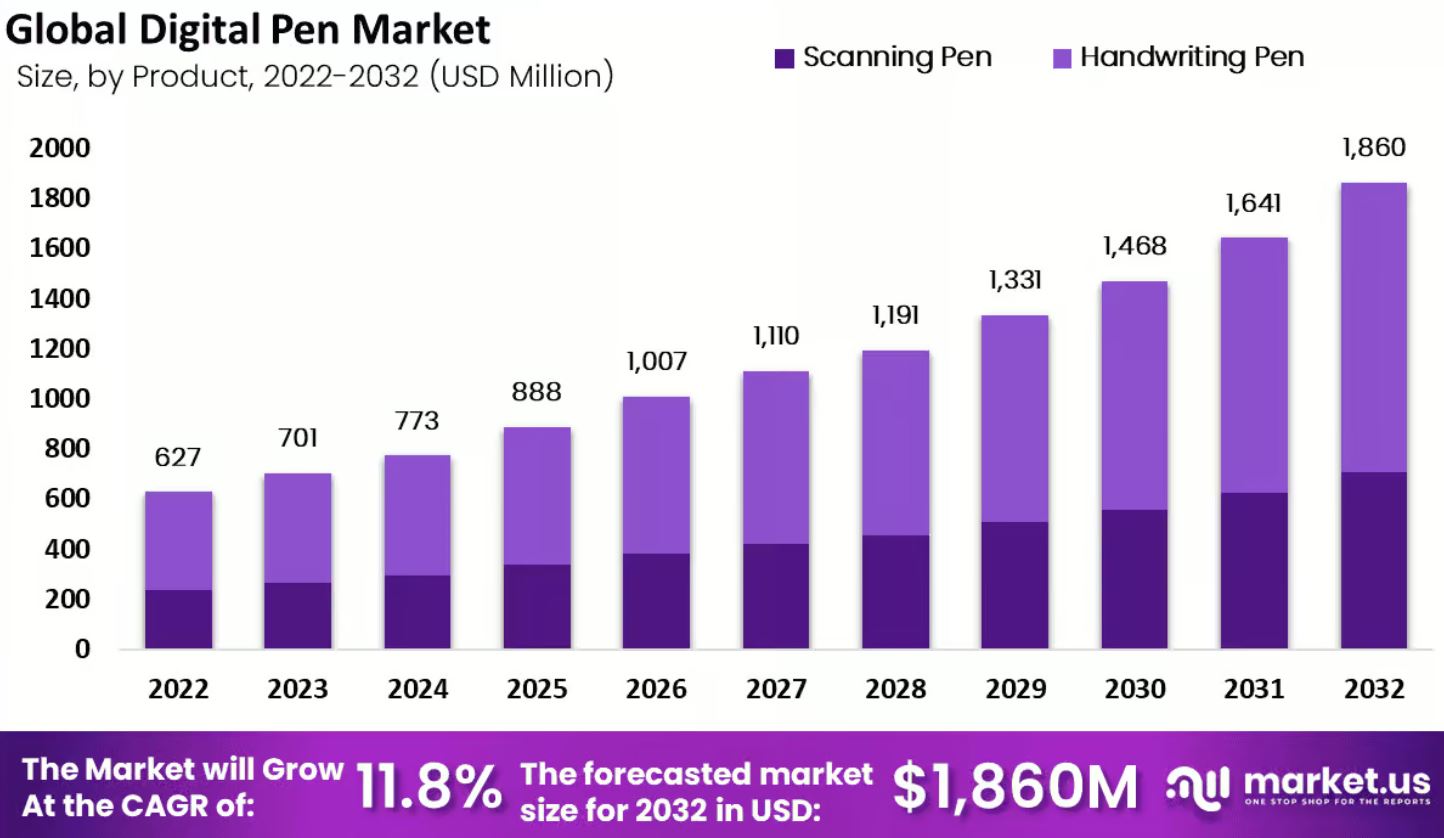
(Source: market.us)
- As per the Market.us report, Digital Pen statistics show that the global digital pen market is accelerating on a strong upward trajectory.
- Being valued at about USD 701 million in 2023, it is projected to nearly triple by 2032 to about USD 1,860 million.
- This steady rise is explained by the presence of an 11.80% compound annual growth rate (CAGR), forecasting that, on average, from 2023 to 2032, the market is projected to grow by almost 12%.
- Such rates of growth are very high in the tech-accessory market, therefore indicating that digital pens are becoming more and more important for the education, business, and creative industries.
- Market-wise, the handwriting pen segment stood out in 2022 as the leading product category held more than 62% of the total market share.
- It signifies that most consumers and organisations are purchasing digital pens for writing on the digital medium, such as for note-taking purposes, for completing forms, or for giving a digital paper-facsimile of an electronic signature.
- This gives a theory behind its dominance because, after all, handwritten input remains one of the most natural ways and one of the most commonly used methods of interacting with digital devices.
- On the other hand, the tablet was the largest demand-creator for digital pens during 2022.
- The tablet segment alone accounted for more than 47% of the market share, meaning that almost half of all the usages of digital pens are tablet-related.
- This makes complete sense since tablets tend to be designed with stylus functionality in mind. This could be for education, professional designing, or business meetings.
- The vast adoption of tablets in schools, offices, and creative studios has hence positioned it as the key platform for digital pen use.
Digital Pen Regional Statistics
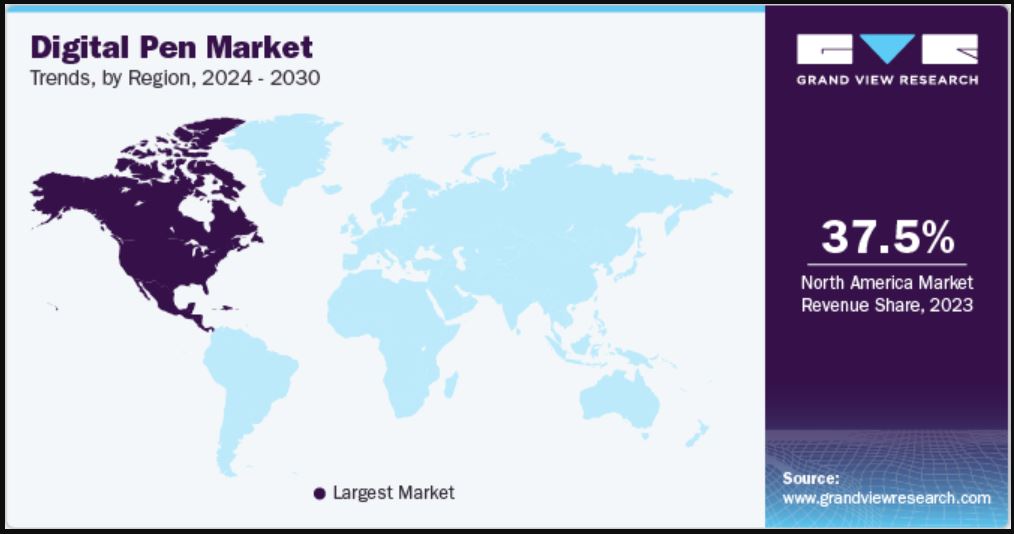
(Source: grandviewresearch.com)
- According to Grandview Research, Digital Pen statistics show that the digital pen market in the United States will witness steady progress at a CAGR rate of 13% during the forecast period.
- Education acts as the major factor driving market growth. Digital pens are especially helpful for students as they facilitate note-taking and allow notes to be shared instantly in digital form.
- The proliferation of digital textbooks and interactive notebooks for a fun learning environment further boosts the use of digital pens.
- Additionally, the integration of e-exam systems, recording, and e-notes across several schools in the United States makes digital pens an essential element on campus, ultimately promoting market growth.
- In the Asia-Pacific region, it is optimistic that the market will accelerate at a CAGR of 14.6% during 2024-2030.
- The forecast of faster growth is supported by the activities observed in China and South Korea, where several domestic companies manufacture digital pens with almost the same functionalities as those of the premium brands but are offered at a much lower price.
- Such inexpensive yet highly functional products have greatly enhanced the acceptability of digital pens among the general population.
- Simultaneously, countries such as Japan, India, and China are pushing government-led digitalisation efforts, resulting in increased proliferation of digital tools, including digital pens, for education, work, and everyday use.
- Looking at India, the market is predicted to witness an even higher CAGR of about 15.6% from 2024 to 2030.
- This rapid growth is attributed to the growing popularity of digital learning platforms within schools and colleges that heavily rely on tablets and other touch-enabled devices.
- As offices, too, are gradually moving toward digital operations, a greater number of professionals are now utilising digital pens for signing documents, annotating files, and collaborating more efficiently, all of which contribute to the demand.
- The digital pen market is projected to exceed USD 575 million in valuation by 2030.
- Local manufacturers hold a dominant share through huge R&D investments, which have led to major innovative developments.
- Improvements such as better pressure sensitivity for more natural writing and drawing, nibs that can be customised to feel like a variety of traditional writing tools, and even including AI features to make taking notes smarter and more intuitive.
- These innovations, combined with affordability, have made China one of the greatest markets for digital pens worldwide.
Digital Pen Usage Statistics
- Tablets accounted for the leading portion of global digital pen sales in 2023, with a share of approximately 59.2%.
- Tablets are also slated to become the fastest-growing segment with an anticipated CAGR of above 14% during 2024-2030.
- This growth has basically been the result of its increasing utility in offices and businesses, as well as colleges and universities using tablets increasingly for learning.
- Institutions are moving more toward smart presentations and digital note-taking, most of which takes place on tablets, with laptops and desktop computers sharing significant time.
- Both of these devices increase demand for digital pens so that users can write, annotate, and share information.
- In brief, during the 2019–2020 school year, about 3,982 degree-granting postsecondary institutions were reported in the United States by NCES.
- These form a huge base of students and faculty that benefits from digital pens for e-learning, note taking, and academic work, thus making education a major contributor to market growth.
- As technology came into being, the manner of writing also started to change.
- Pen and paper are being plucked out of their usual spot, especially now that digital devices can facilitate easy storing, editing, and sharing of notes.
- This transition has further helped the digital pen in wider acceptance for educational and recreational purposes.
- Other industries besides education and office ploys include healthcare and manufacturing for digital pen-driven realisation.
- The latter two sectors are very much dependent on standardised forms and documentation, and digital pens offer the means of fast completion, processing, and storage of such information on PCs and laptops.
Digital Pen Market Revenue
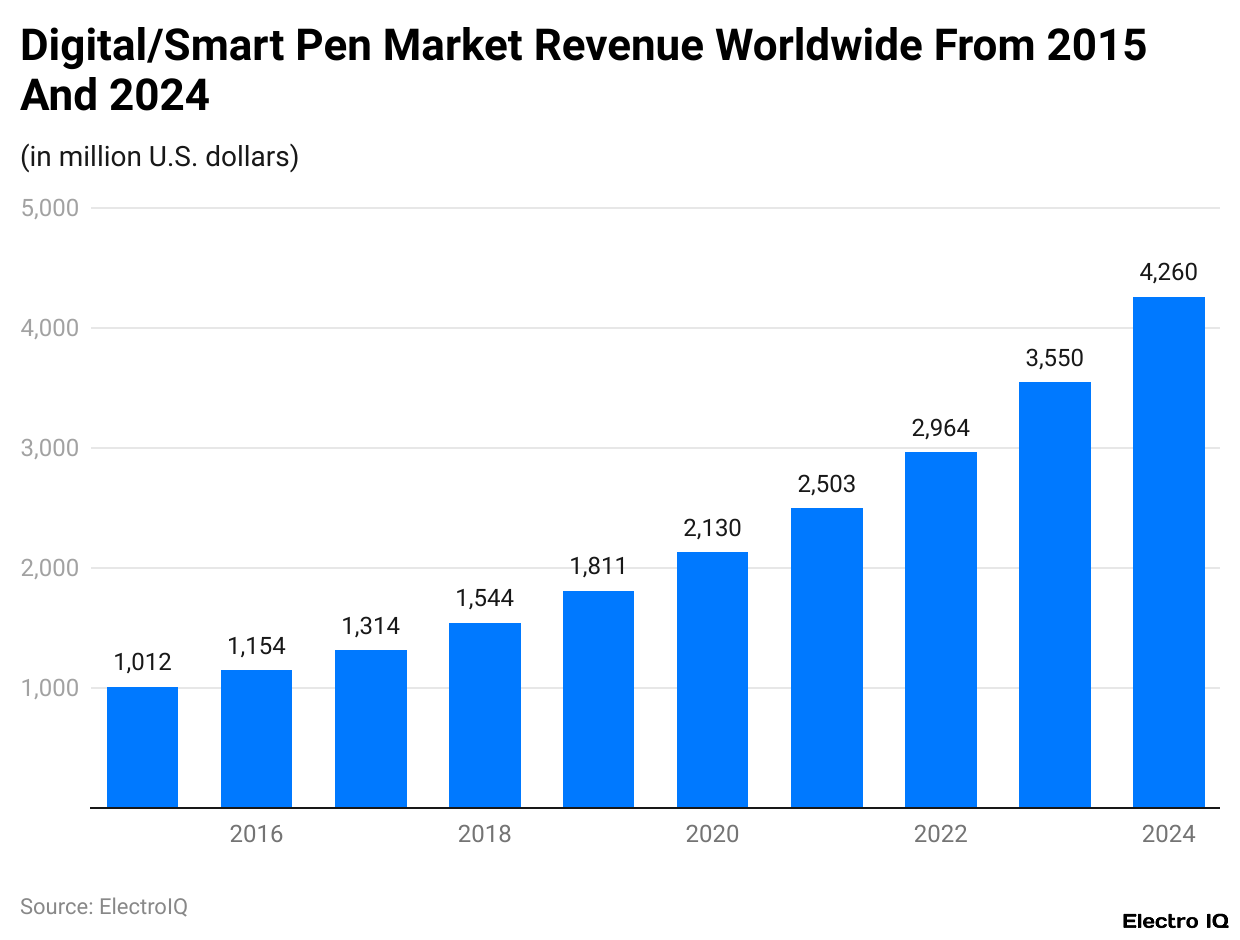
(Reference: statista.com)
- As per a Statista report, Digital Pen statistics show that the data reveals that the global digital pen market has been witnessing steady growth over the past 10 years.
- Revenue was approximately US$1.01 billion in 2015 and increased every year after that, recording US$1.15 billion in 2016, US$1.31 billion in 2017, and US$1.54 billion in 2018.
- Growth then sped up, with the market reaching US$1.81 billion in 2019 and surpassing the US$2-billion mark at about US$2.13 billion in 2020.
- In 2021, expansion accelerated even further. The market produced roughly US$2.50 billion in 2021 and rose further to US$2.96 billion by 2022.
- The market’s size saw further notable growth in the year 2023 to US$3.55 billion, high enough to hit an estimate of US$4.26 billion in 2024.
- This therefore means that over less than 10 years, the global digital pen market has grown by over four times, from a little more than US$1 billion in 2015 to more than US$4.2 billion in 2024.
- This showcases burgeoning demand growth, with digital pens enjoying ever greater acceptance worldwide in education, business, and the arts.
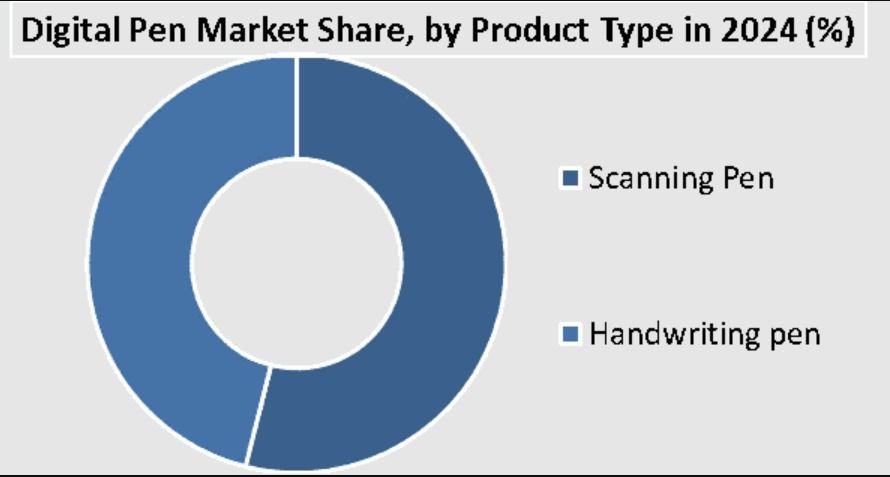
(Source: coolest-gadgets.com)
- The digital pen market is split into various end-user verticals, including healthcare, BFSI (banking, financial services, and insurance), IT and telecom, government, and other sectors like retail and education.
- Out of all these sectors, healthcare has witnessed the most technological advancement, thereby giving it a lucrative revenue stream.
- In fact, the healthcare industry holds the lion’s share within the digital pen market, accounting for more than 50%.
- Digital pens are slowly but surely finding their way into healthcare because of the association with health-monitoring devices.
- Digital pens and smartwatches are being used to assist patients, mainly those with mobility challenges, by easing the burden of tracking health data, signing documents, or interfacing with electronic medical records.
- Such devices can further enhance handling efficiency for both these patients and the providers.
- This combination of sophisticated technological application and top-dollar pricing ensures healthcare is the driver for the digital pen market as opposed to any other industry.
Digital Pen Used In Different Sectors
- In 2024, the use of the digital pen was not uniform across the sectors; each, however, was propelling its own demand.
- During this phase, the education sector was pegged at about a billion and US$150 million due to large-scale deployments of tablets in schools and the rise of projects dealing with interactive classrooms.
- Educational institutions had a higher preference for mid-range, sturdy digital pens or those bundled with tablets, since offering a better price advantage for mass deployment at the student level.
- In trade and field work, sectors such as banking, logistics, and insurance mostly depended on digital pens for signing documentation, filling forms, and capturing data in the fields.
- In efforts to balance convenience and compliance, most of these organisations bought pens integrated with secure tablets or signature capture devices.
- Analysts view enterprise usage as one of the strongest growth drivers in this overall market.
- Illustrators, graphic designers, and digital artists went for active pens and pen displays with high levels of precision, especially ones featuring more than 4,096 levels of pressure sensitivity and the ability to detect tilt.
- Demand for such premium items kept average selling prices in the creative segment high, making it a very attractive segment for manufacturers focused on design and artistry.
Key Players In The Digital Pen Industry
Apple Inc.
- Apple is one of the frontiers in the digital pen market, with particular emphasis on the Apple Pencil line of styluses.
- The styluses are heavily integrated into the iPad ecosystem and are therefore widely accepted by students, professionals, and creatives.
- The company works on increasing the level of precision, responsiveness, and user experience, so the Apple Pencil would always be one of the top choices for tablet users.
Microsoft Inc.
- The Surface Pen has been a fierce competitor; it is made for the Surface tablet and laptop lineup.
- Recently, its updates have improved pressure sensitivity and tilt recognition, making writing or drawing natural.
- With productivity tools supporting the creative user, Microsoft appears to be at the forefront of business and artistic applications.
Livescribe Inc.
- The company is carving out its niche in the education and business sectors.
- It’s smart pens digitise handwritten notes while simultaneously recording audio.
- This dual functionality is highly appreciated in the classroom and professional environments that demand recording both written and spoken information.
IRIS S.A.
- IRIS expanded its presence in the digital pen market by investing in OCR technology.
- The company is acquiring players in order to enhance its quick and accurate conversion of handwritten notes into editable digital text, thereby giving additional value to competitors’ listeners who require fast note digitisation.
Wacom Co., Ltd.
- Wacom has one of the strongest identities in digital creativity tools.
- Artists, designers, and illustrators are the primary target market of the Wacom drawing tablets and styluses.
- Its new pens are ergonomic and offer greater device compatibility, thereby strengthening the reputation of Wacom as the leader in creative solutions.
Moleskine S.p.A.
- In the case of Moleskine, a hybrid approach is taken to traditional and digital writing.
- By coupling its iconic notebooks with digital pen technology, Moleskine allows users to write on paper while simultaneously syncing notes to a digital device.
- This analogue-digital hybrid approach is appealing to users who like the feel of handwriting but want to share or store their writing digitally.
Conclusion
Digital Pen Statistics: The digital pen market is growing fast with increasing demand in education, healthcare, business, and creative areas. Digital pens give people the opportunity to easily write, draw, and sign on documents, with more tablets and smart devices being used in schools, offices, and clinics. By 2032, under the powerful U.S., India, and China growth, the market will almost see a threefold increase.
Tablets are the most widely used devices for digital pen applications, mostly in schools. Its innovations come from big patent holders like Apple, Microsoft, and Wacom. With digitisation flowing through various markets, the need for accurate and easy-to-use pens is growing throughout the globe.
Sources
FAQ.
The global market for digital pens is expanding fairly rapidly. Estimated to be worth about US$701 million in 2023, it has an expected value of US$1.86 billion in 2032, with an impressive CAGR of 11.8%. Revenue has actually increased quadrupled within less than a decade, from a little over US$1 billion in 2015 to US$4.26 billion in 2024, showing a consistent cross-industry adoption at the global stage.
Pen-writers are the most used type of pens due to the usefulness of pen-writers for note-taking, filling forms, and digital signatures, thus holding a market share of more than 62% in 2022. Tablets are among the most in-demand devices, with 47% of the market share in 2022 and 59.2% of sales in 2023, along with a roaring projected growth of 14% CAGR (2024–2030).
Growth varies region-wise, with the U.S. market expected to grow at a CAGR of 13%, mainly fueled by its adoption in the education sector. The APAC is growing even faster at 14.6% CAGR (2024–2030), with key markets like India at a 15.6% CAGR, driven by adoption in digital learning platforms and workplaces, and China, standing to surpass US$575 million by 2030, driven by local innovation and affordability.
Healthcare is leading by more than 50% in market revenue due to advanced medical tools, electronic health record systems, and very expensive professional devices. Education is another major sector standing close to US$1.15 billion in 2024, with tablet rollouts having been deployed at scale.
Several multinational names are prominent in the sector. Apple leads with the Apple Pencil supporting the iPad ecosystem, while Microsoft lends powers to productivity and creative use with the Surface Pen. Wacom stands as another leading brand for creative professionals, being known for precise drawing tools. Livescribe excels in smart pens that digitise notes and record audio, IRIS focuses on OCR-powered solutions, and Moleskine sides with traditional notebooks combined with digital syncing targeted toward hybrid users.

I hold an MBA in Finance and Marketing, bringing a unique blend of business acumen and creative communication skills. With experience as a content in crafting statistical and research-backed content across multiple domains, including education, technology, product reviews, and company website analytics, I specialize in producing engaging, informative, and SEO-optimized content tailored to diverse audiences. My work bridges technical accuracy with compelling storytelling, helping brands educate, inform, and connect with their target markets.


